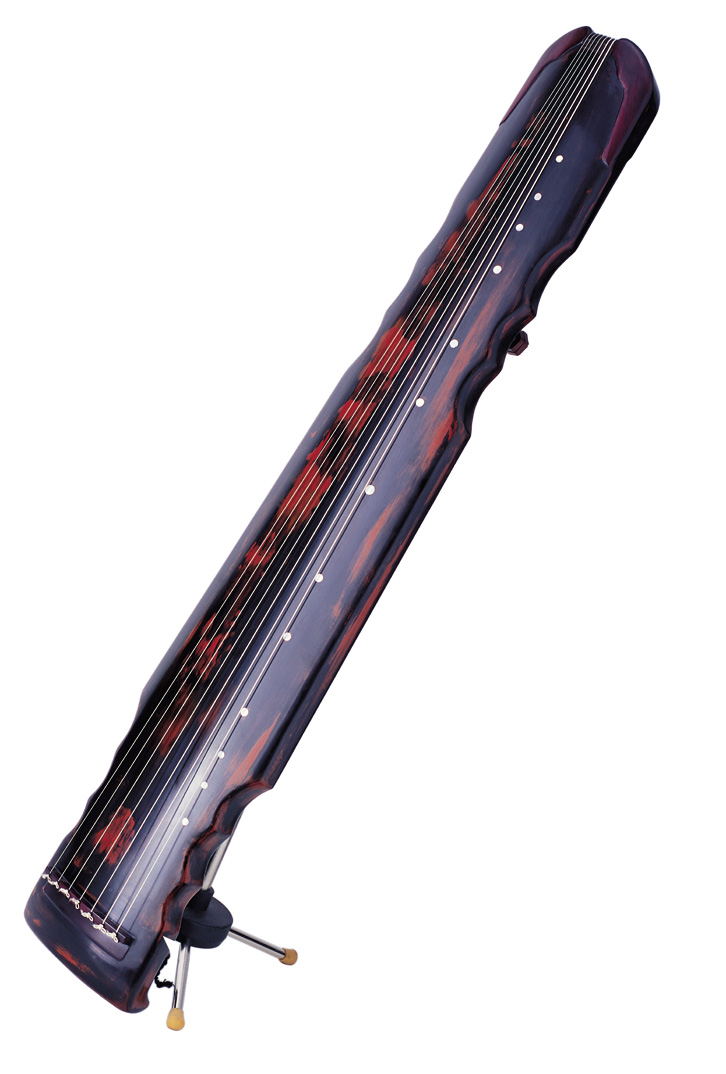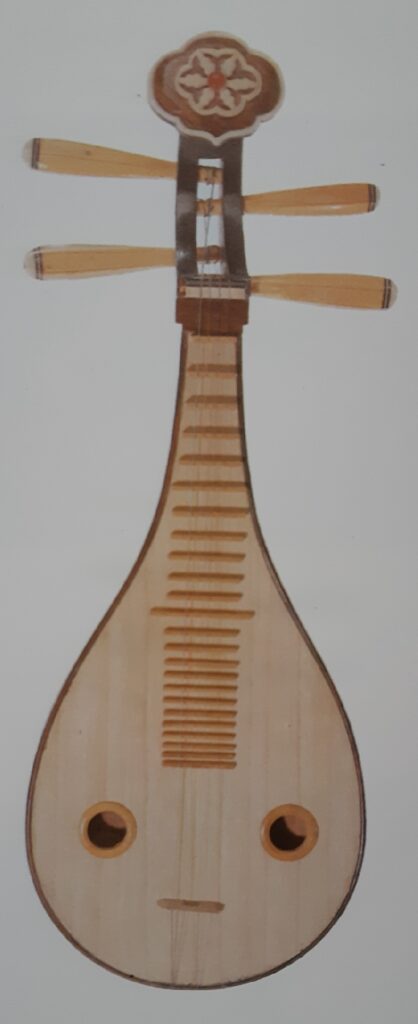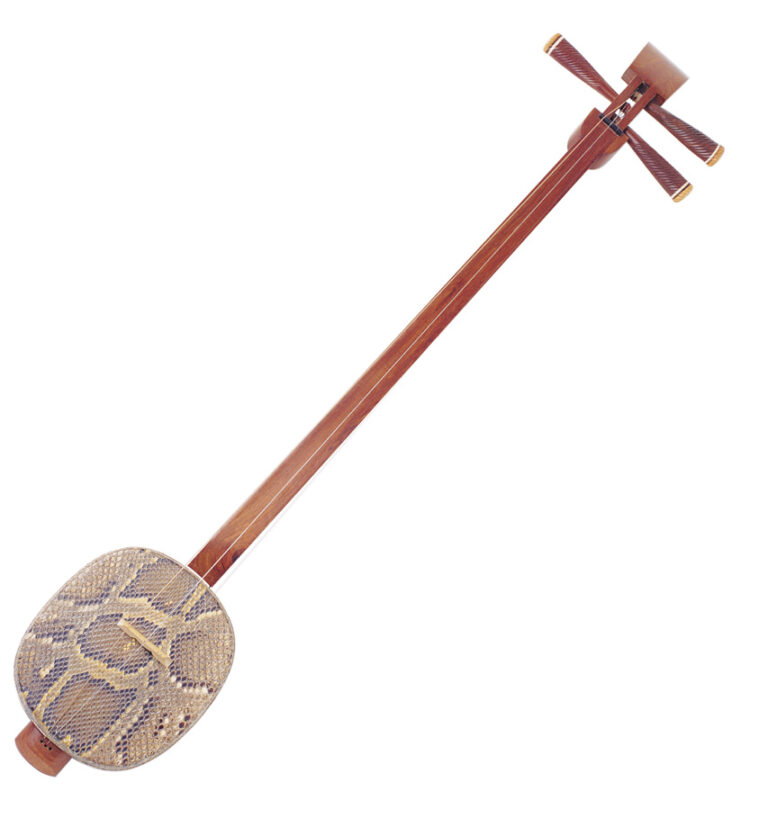中國民族音樂資料館 Chinese Music Archive
彈撥類 Plucked String Instruments
古琴 - Guqin
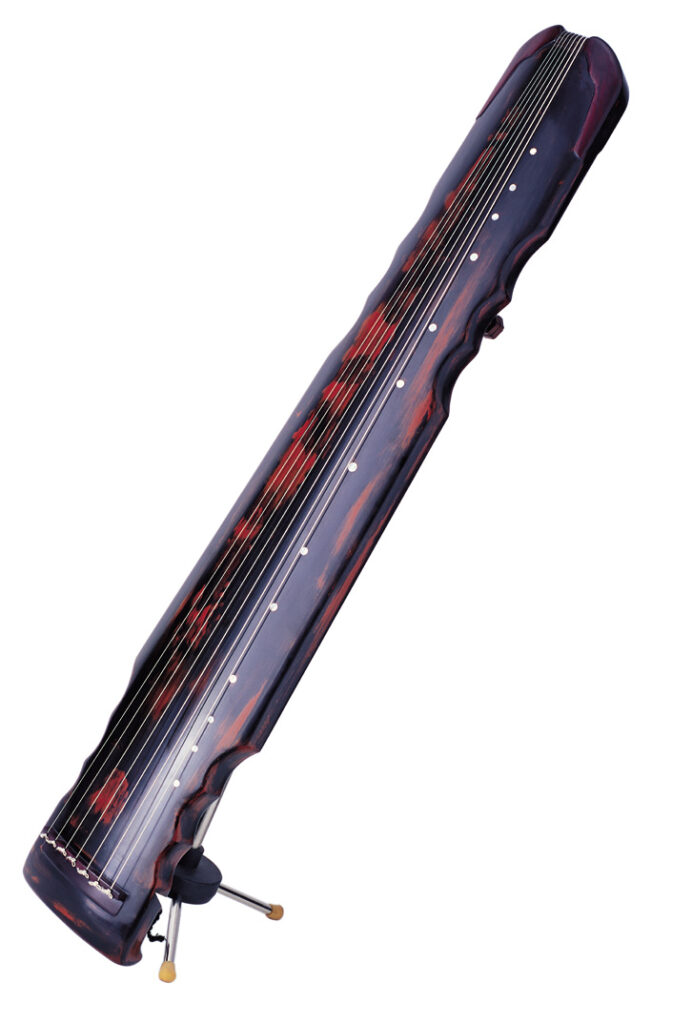
古琴,亦称“七弦琴”,史籍中多称“琴”。唐诗有“泠泠七弦上,静听松风寒”之名句,“泠泠七弦”指的就是古琴。春秋擂鼓墩墓与西汉马王堆墓出土的“琴”更证实了它的历史之长久,《诗经》、《尚书》等古籍和唐宋诗词中也常常见到有关“琴”与琴乐的记叙。所以,古琴是中国历史十分悠久的一件民族乐器。至今大型博物馆内和琴家私人收藏中还能见到唐、宋、元、明、清年代的古琴。
古琴由狭长的一块桐木面板(也有用其他松质木材)和一块梓木底板(也有用其他硬质木材)胶合而成,外表髹以中国大漆。琴面外侧嵌有十三个小圆点的“徽”,为泛音和按音音位的标志。琴面繫弦七根,外侧至内侧由粗至细,横置于琴卓上演奏。与很多乐器相比较,古琴有如下独特之处:古琴弦的有效振动弦长超出一般乐器的弦长,振幅宽大,音质低沉浑厚,幽静古朴;古琴的面板即指板,无品无柱,出音孔开于底板,向下传音;琴上存有一百多个实用的泛音,堪称乐器之最。
在一千五百年以前古琴曲《碣石调‧幽兰》已由专用的记谱法——“文字谱”记成并流传至今。唐朝时又将文字谱改进为“减字谱”,经千馀年传衍。历代琴家编簒刋印了一百五十馀部琴谱谱集,其中共收录了三千馀首琴曲和琴歌,以及大量的理论文字篇章。古琴音乐的遗产蔚然大观,浩如烟海,可谓是中国民族音乐中的瑰宝,已引起海内外音乐史家、音乐理论家的重视。
古琴音乐的“打谱”
古琴音乐的“打谱”,是对大量记载在古琴谱集中的久已失响的琴曲进行译谱、整理、考证、鉴别以及表演性的再创作等多种因素的一项综合性的音乐活动。
打谱者必须要对所打谱的琴曲的时代、作者、各种版本、历代琴家的评述以及历代记谱法的沿革有较详实的深入研究,尽可能地忠实于历史,并通过演奏,还原原曲的风貌。此项音乐活动仔细而繁杂,故有打谱一首琴曲需费时“小曲三月,大曲三年”之说。
Guqin (Ancient Zither)
Guqin, also called “Seven-stringed Zither”, was rendered as “qin” in most ancient writings. The discovery of the remains of the qin in ancient tombs (500 to 200 B.C.), together with the description of the qin and its music in many ancient writings assured us of its long history. Today, qins of the Tang Dynasty (700 A.D) up to the Qing Dynasty (19th Century) still exist in museums and in collections of modern qin players.
The qin consists of a long, narrow upper wooden board made from tong tree (or other trees of the pine family) and a lower board made from catalpa tree (or other hardwood). These two pieces of boards are stuck together and lacquered on the surface. There are 13 small dots (call hui) inlaid on the outside of the upper board, which mark the positions of the musical notes and their harmonics. Seven strings are fixed on the upper board, starting from the thickest one on the outside to the thinnest one on the inside. When played, the qin is put on a table.
When compared with other instruments, the qin is special in the following aspects:
- The effective vibrating length of the strings of the qin is longer than that of other instruments, resulting in a large vibrating amplitude and a tone rich in the lower register which fits in with the sounds of the nature.
- The fingerboard of the qin is the upper board which does not consist of any frets. Sound holes are opened on the lower board, which means that the sound is transmitted downwards.
- Over 100 overtones (harmonics) can be played on the qin. It is probably the instrument which has the largest number of overtones.
1500 years ago, music for the qin was recorded by words, which were called “Literal scores”. During the Tang Dynasty, “Simplified scores” were developed and used from then on instead of the “Literal scores”. Over the centuries, qin players published over 150 books on qin music, which included over 3,000 pieces of music for the solo qin or songs with qin accompaniment, and also plenty of articles on theories about the qin. The legacy of qin music is so rich that it is now considered as the gem of Chinese traditional music and catches the attention of experts on music history and musicologists around the world.
Transcription of Qin Music
Transcription (dapu), in qin music, means interpreting, arranging, examining, differentiating and re-creating, for performing purposes, the large number of pieces of music for the qin recorded in ancient documents.
The person who does the transcription of a piece of qin music must have an in-depth research on the period, composer, different versions of the piece, descriptions of the piece by qin players over the centuries and the development of scoring methods of the qin. He tries his best to be faithful to history and recovers the original sounds of the piece through performing it. It is a complicated and tedious task. It has been said that it took “three months for a small piece, and three years for a large piece”.
琵琶 - Pipa
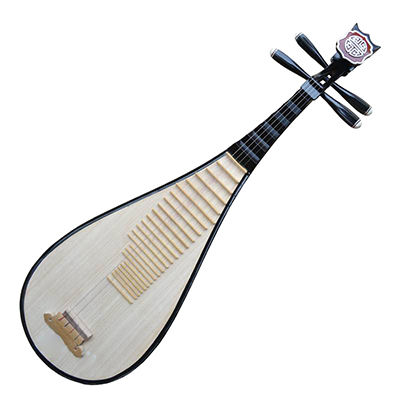
“琵”和“琶”原是两种弹奏手法的名称,琵是右手向前弹,琶是右手向后弹。秦、汉至唐一段时期,琵琶二字曾作为多种弹弦乐器的总称。那时候,不管琴杆长的、短的,圆形音箱的、梨形音箱的,木面的、皮面的,弦数多的、弦数少的,横著弹的、竖著弹的,凡是奏法相似的,一律称为琵琶,而不是某个乐器所专用的名称。到了宋代,才开始使琵琶这一名词,由广义变为狭义,专用于称呼梨形音箱的曲项琵琶。
秦、汉时,出现了两种琵琶。约在公元前二一四年,我国人民参考鼗(tao)鼓的形制创造出一种直柄、圆形音箱、两面蒙皮,用手弹拨的乐器,叫做弦鼗,又名琵琶,约在公元前一○五年,我国人民又参考了筝、筑、箜篌等乐器,创造出一种木制直柄,圆形音箱,有四根弦,十二柱,竖抱著,用手弹拨的乐器,也称之为琵琶。后人称这种琵琶为秦琵琶。晋阮咸以善弹此乐器闻名,故又称之为阮咸,简称阮。
约在四世纪(约公元五三○年左右),有一种曲项琵琶,通过印度传入中国的北方。公元五五一年以前,又传到南方。它适应我国歌舞艺术的发展,在隋唐时代大大地盛行起来,被视为当时重要弹弦乐器之一,唐代大曲常用它来领奏。琵琶除了作为独奏乐器以外,也用于伴奏歌曲、歌舞、曲艺、戏曲及器乐合奏。
现在的琵琶,吸取曲项琵琶的形式,结合秦琵琶的优点改革而成。原先外来的曲项琵琶是木质梨形音箱,曲颈、四弦、四柱(即相位,没有品位),用拨子弹奏。经过我国人民在长期实践中不断进行改革,吸取了阮多柱、手弹等优点,发展为十四个柱,由横弹改为竖弹,由拨弹改为手弹。在形制上,在音域上,在演奏效果上,已与原先的曲项琵琶大不一样。新中国成立后,琵琶又有了更大的发展,由丝弦改为钢丝弦,或尼龙缠钢丝弦;增加为三十一个柱(六相二十五品),有十二个半音,可转十二个调;扩大了音域和音量,音色明亮,提高了琵琶的表现力。
Pipa, was originally referred to two plucking techniques “pi” and “pa” for all the plucked string instruments in East Han Dynasty period. These were the right hand techniques, pi was played in forward direction and pa was played in opposite direction. At that time, all of the plucked string instruments were then began to be called “pipa”. Around the fourth century (around 530 AD), a kind of pipa, shipped to China through northern India. Then it was widely spread to the southern part of China and well developed in Sui and Tang Dynasty. In addition to being a solo instrument, pipa also used for accompaniment of songs, dance, opera and always used in instrumental ensembles. After a long development period, the imported pipa has ongoing reformed to a pear shape instrument with four strings, use fingers instead of pick for plucking and changed the performing style from horizontal to vertical. The substance of the strings has also changed from silk to nylon and steel.
古筝 - Guzheng
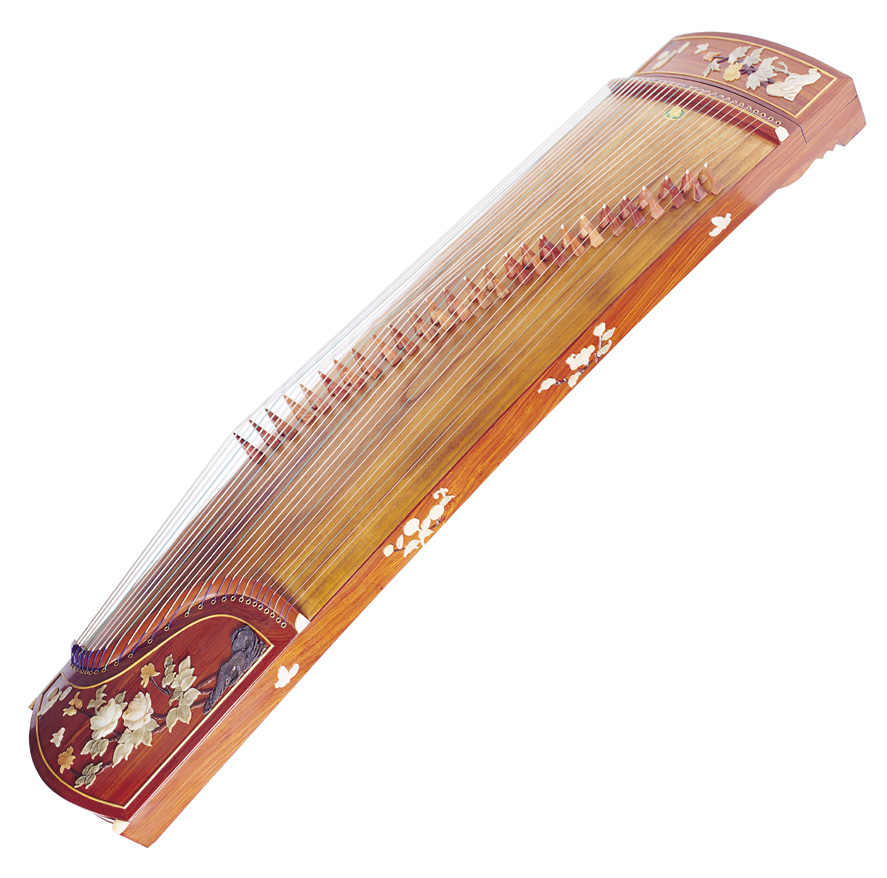
古筝原称筝,是我国比较古老的民族乐器之一,远在战国时代(公元前四○三至二一一年)就流行于当时的秦国(现在的陝西省)境内了,所以有“秦筝”的名称。
从我国古代历史材料里,和古代文人的诗、词、歌、赋里,都可以看出它不但是广大劳动人民所喜闻乐见的东西,并且也是为热爱这种乐器的劳动人民所掌握著的。《史记‧李斯谏逐客书》里所说的:“弹筝搏髀……真秦之声也”和《汉书》《盐铁论》里所说的“往者民间酒会各以党俗,弹筝鼓缶而已”。就可以证明这一点。
若再从汉侯瑾、魏阮瑀、晋贾彬等人的《筝赋》和唐人白居易、李白、张九龄等人的《咏筝诗》,以及宋人欧阳修、晏儿道等人的《咏筝词》的描写中,便也可见到筝在民间音乐中的地位。
筝虽然是发源于古代秦国地方,但因历史的变迁,它已经逐渐成为河南、山东、广东、云南、浙江等地的地方乐器;而在今天,在文艺路线和改革出新下,它已经得到更大的推广和发展,所以说它不仅是上述少数地区的民间乐器,而是有悠久历史的民族乐器。
筝的音箱是用梧桐木刳凿成长方形音箱,面板呈弧形,弦张在面板上,过去各地流行的筝,或用蚕丝弦,或用铜丝弦,弦数由十二到十六不等,每弦一个撑弦码子,称“雁柱”,用以调节弦长,固定音高,一般是按五声音阶定弦排列;音箱底部平坦,设音孔二,称为“越”。传统的演奏技法是用右手大、食、中三指弹弦取音,可用肉甲或义甲拨弦,左手食、中、名指捺弦,可奏出按、颤、揉、推等变化音,近年来,这些基本技法又已作了新的发展。
新中國成立後,箏有了很大的改革,一般使用了鋼絲弦或尼龍包鋼弦,並增加了弦數,現已有十九弦、二十一弦、二十五弦等多種,有些品種設有機械變音裝置,能轉十二個調,改革後的箏,音域擴大,音量增加,表現力豐富。
–Guzheng
Guzheng is also called zheng. It is one kind of the oldest Chinese traditional musical instrument. Upon the Warring States period (403 – 211 B.C.), it was most popular in Qin territory (now Shaanxi province). So it was also called “Qin Zheng”.
According to the historical records from the poetry and other writings, they told us that the instrument was beloved by the public and most people could manage it. It also reflected the importance of it in the civil through music history.
Although zheng was originated from Qin territory, it was gradually spread to Henan, Shandong, Guangdong, Yunnan, Zhejiang provinces and became their civil instruments. Today, zheng has been greater developed and is one kind of the traditional musical instruments among the people in China.
The sound box of the instrument is made by a long wooden board from tong tree. On the upper arch-shade side is load with strings across the separate bridges. In the past, the strings were made with silk, or bronze. Nowadays, they are made with steel and nylon. And the number of strings has developed from twelve to twenty five. On the lower flat side, there are two sound holes. The smaller one near the head of the instrument is used for affixing the strings. While the bigger one in the middle is used for the sound to transmit downward.
扬琴 - Yangqin
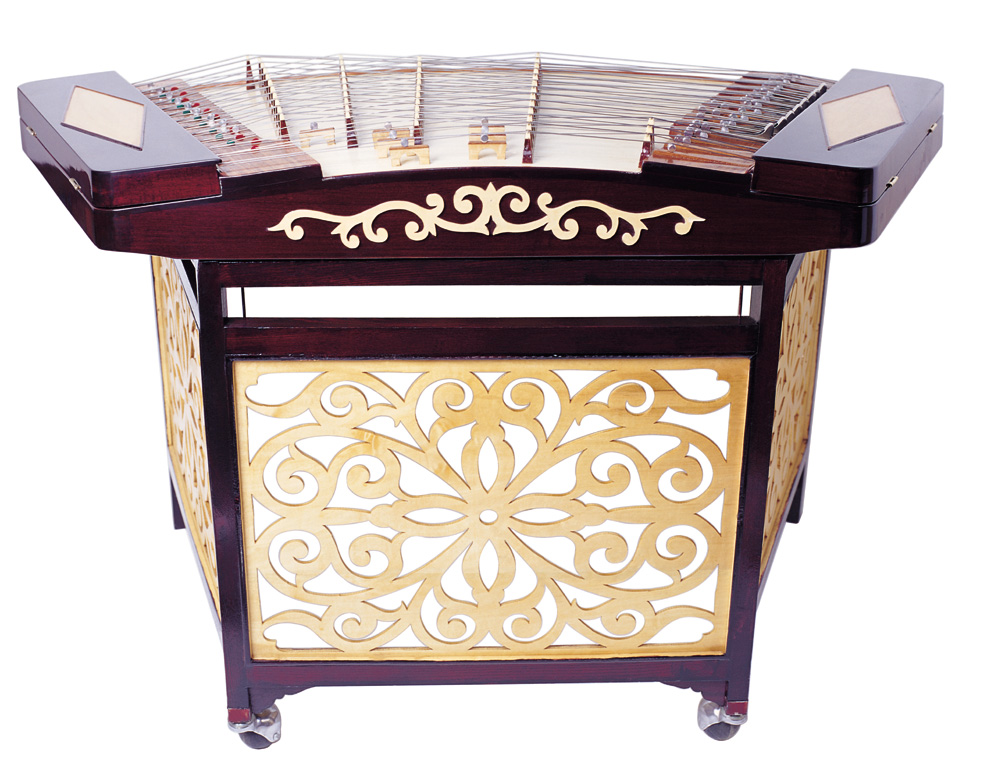
扬琴,相传在明代(公元一三六八至一六四四年)传入中国,最初流行于广东一带,现已流行全国。常用于戏曲、曲艺的伴奏,也用于合奏及独奏。
扬琴音箱木质梯形,上张若干根钢丝弦,奏时用竹槌敲击发声,音色清亮,可以奏两组以上的音。
新中国成立后,扬琴有了进一步的发展,加大了琴身,增加了弦数,扩大了音量和音域,能奏出有十二个半音的四组音,可以转调。音色清脆、嘹亮,可独奏、伴奏和合奏。
Yangqin also known as the Dulcimer was delivered to China since the Ming dynasty (1368-1644 A.D.), it was initially popular in Guangdong province and later on spread widely to other provinces. It was mostly used as the accompanied instrument of various operatic music, folk singing and talks. After development, it was also used for solo and ensemble music. It has a wooden ladder shape sound box which is mounted with strings over the bridges. It is performed with bamboo strikers and has a clear and melodic tone colour. It can be played up to more than two octaves in the scale. Nowadays, it is developed on the size and the number of string and bridge. It can be played four octaves in chromatic scale.
柳琴 - Liuqin

柳琴,因它形状像柳叶,所以叫柳琴或柳叶琴。是苏北鲁南一带的柳琴戏及安徽泗洲戏的主要伴奏乐器。
原来的柳琴是二弦,七品,丝弦,用拨子弹奏。新中国成立后,对柳琴进行了多次改革,制成了高音柳琴,将二弦七品改为四弦二十四品,依半音排列,扩大了音域,便于转调;又改丝弦为尼龙弦,增大了音量,使音色更加优美。高音柳琴丰富了民族乐队弹弦乐组的高音部。
Liuqin is so called, because it has a willow-leaf shade sound box. It is an instrument of the operatic music spread along the northern Jiangsu, southern Shandong and Anhui. The original liuqin has only two strings, seven frets and use a plectrum to pluck on the silk strings. Nowadays, it is developed to have four strings and twenty four frets in chromatic scale. The silk strings are reformed to steel-nylon strings. It is now the chief soprano plucked instrument of the ensemble.
月琴 - Yueqin
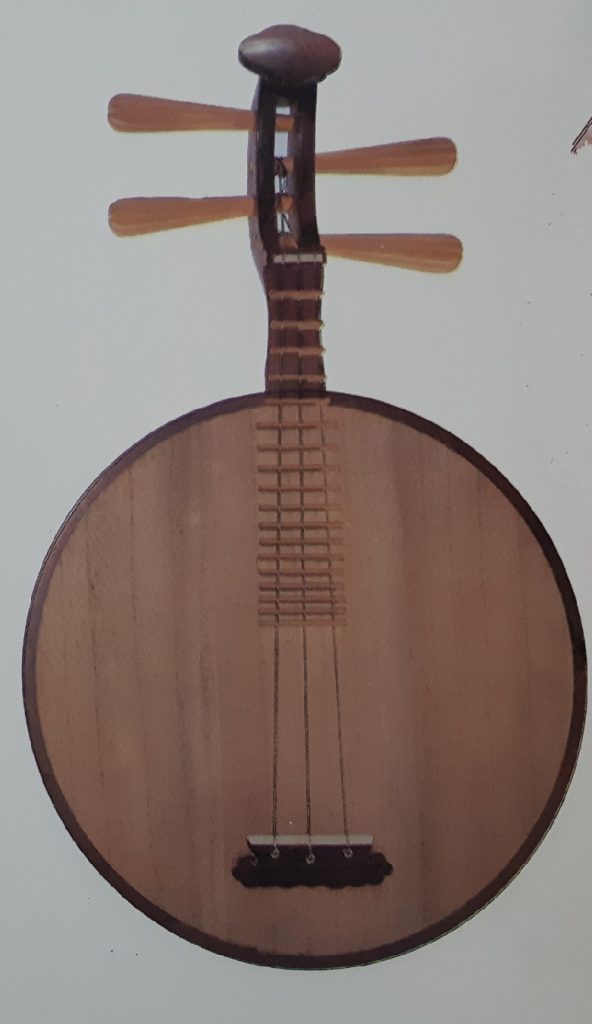
月琴是由阮衍变而成,在民间流传很广,常用于戏曲、曲艺伴奏及独奏、器乐合奏。在京剧中,与京胡、京二胡一起称为三大件。西南彝族称月琴为弦子,常用以边弹边舞。
月琴的音箱,一般是木质圆形,也有八角形的,张四根丝弦,分成两组,每组两弦的音高相同,七品。音色清亮。通常是五度定弦,用拨弹奏。
新中国成立后,对月琴进行了改革。有一种改革后的月琴,加宽了琴颈;品位增多至二十四品,按半音排列,便于转调;弦改为钢丝尼龙缠弦。音色清脆、柔和。
Yueqin is developed from the ancient instrument called ruan. It is widely spread in many districts and be used as the accompanied instrument of various operatic music, folk singing and talks. After development, it was also used for solo and ensemble music. In the Beijing Operatic Music, it is used together with the jinghu and jingerhu to form the “Three Majors”. In the Yi minorities of the south-west district, their yueqin is called the xianzi. In general, the sound box of the yueqin is a wooden round shape one, we can also find some octagons. It has seven frets and four silk strings in two groups of perfect fifth. Each group has two strings tuning in the same pitch. Nowadays, it is reformed to have twenty four frets in chromatic scale and the silk strings have changed to steel-nylon string.
三弦 - Sanxian
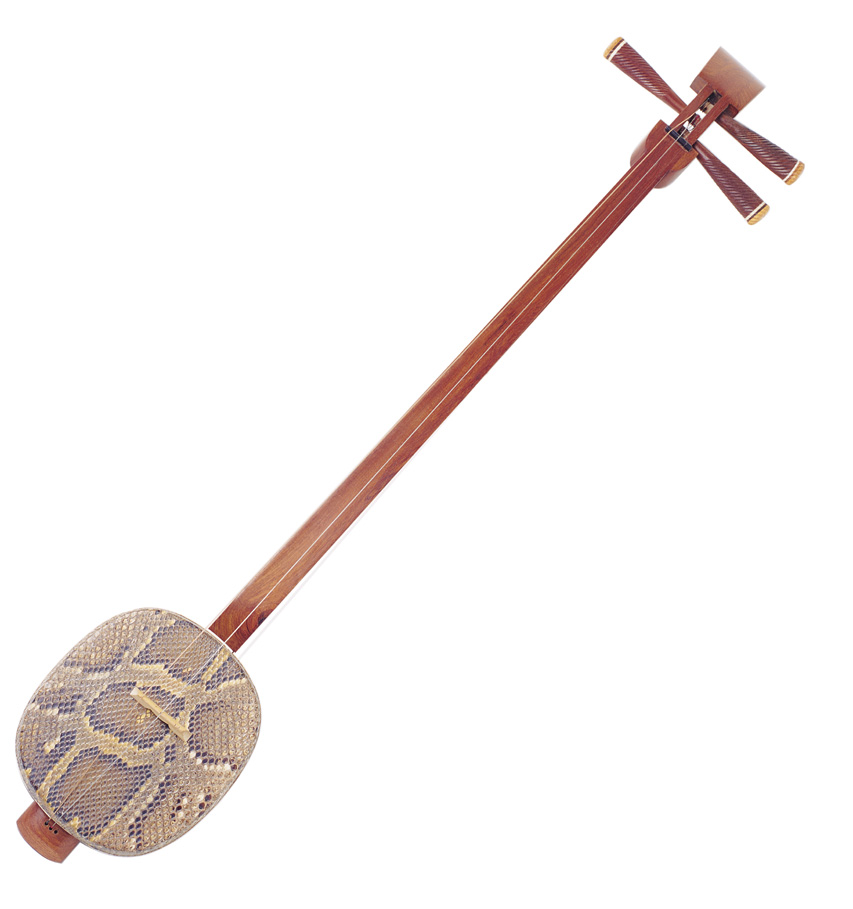
三弦,又名弦子。它的前身可能是秦代的弦鞀。到了元代(公元一二八○至一三六八年)才有三弦之名。
汉族和某些少数民族,都有三弦。汉族的三弦有椭圆形木质、两面蒙皮的扁平鼓头(即音箱),以琴杆为指板,无品位。
约在十九世纪中期,直隶(现在的河北省)高阳县木板大鼓说唱艺人马三峰,又根据小三弦的形式,创造了大三弦,受到当时北方说唱艺人们的欢迎。从此以后,大小两种三弦,同时流行。特别在伴奏说唱音乐方面,形成南北不同的风格。小三弦一名曲弦,音色清亮,用于昆曲、弹词等戏曲和说唱音乐的伴奏,以及十番鼓、十番锣等器乐合奏。大三弦,又名书弦,音色宽宏低沉,一般用于北方大鼓书、牌子曲等音乐的伴奏。
–Sanxian
Sanxian is also called Xianzi and is developed from the xiantao of the Qin dynasty. It was named sanxian since the Yuan dynasty (A.D.1280-1368). It is widely spread in Han nationality and certain minorities. The Han one has a wooden ellipse shape sound box covered with skins in both sides. The long stem (handle) is the finger broad with no frets on it. Around the mid-nineteenth century, the artist MA San-feng of Gaoyang, Heibei province, reformed the small sanxian and initially develop the large sanxian which was well received by the northern artists. Since then, two kinds of sanxians spread simultaneously and formed the music style of north and south. Small sanxian was then call quxian and be used in the southern China. Large sanxian was then call shuxian and be used in the northern China.
阮 - Ruan
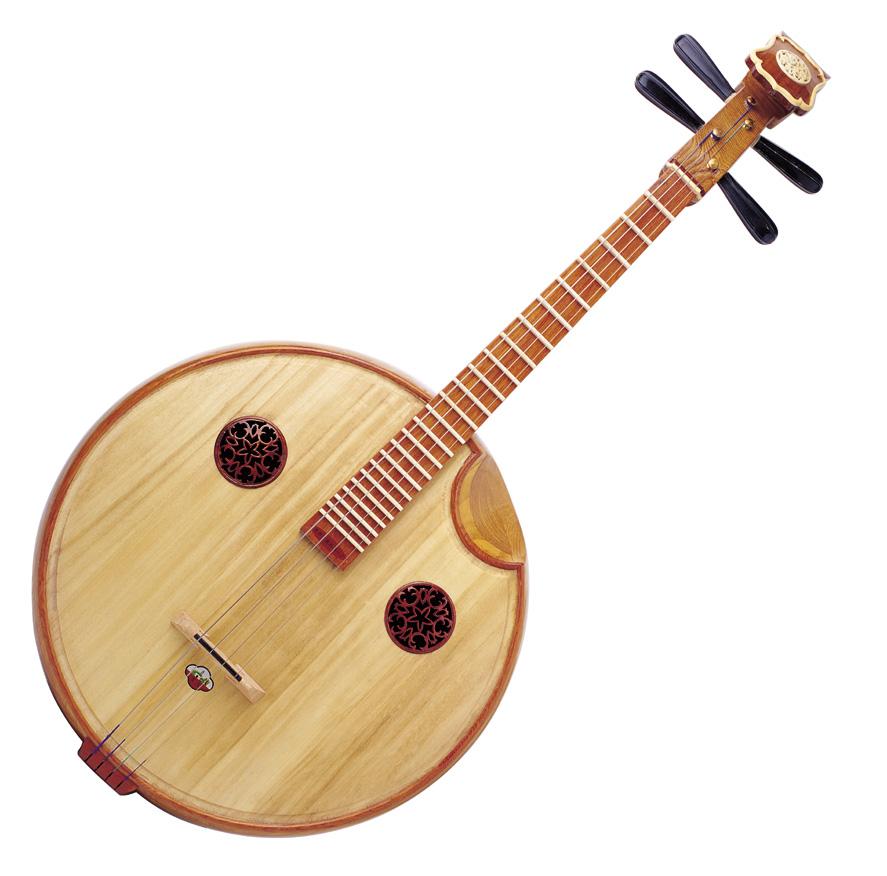
阮,汉武帝时(公元前一四○至八七年),我国人民参考了筝、筑、箜篌等乐器创制而成的弹拨乐器。阮,圆形音箱,直杆,四根弦,有十二个柱位,每个柱位横贯于高低不同的四根弦之间,为四弦所共用。这样的构造说明我国对平均律的使用于此时开始。阮在当时称为琵琶。后人称为秦琵琶或月琴。到唐代已有十三个柱位,唐武则天时,才改称阮咸,近代称为阮。后来的阮,有张四根弦的,也有张三根弦的。柱位也比汉代有所增多。
新中国成立后,对阮进行了一系列改革,在形制上有小阮、中阮、大阮、低阮四种,品位增加到二十四个,扩大了音量,音色更为柔美。在器乐合奏及伴奏里,阮成为重要的弹拨乐器之一。一般常用的有大阮和中阮两种。
Ruan is a kind of plucked instrument derived from zheng, zhu and konghou since Han dynasty (140-87 B.C.) It bears a round wooden sound box and a long stem which has four strings and twelve frets. It was called pipa at that early time. Later on, it was renamed qinpipa or yueqin. At Tang dynasty, it was developed to have thirteen frets and be called ruanxian. It is now generally called ruan and mostly has three to four strings with frets in chromatic scale. Nowadays, it has developed into xiaoruan, zhongruan, daruan and diruan. Each of that bears twenty four frets and become a set of plucked instruments in the ensemble. The zhongruan and daruan are commonly used in solo, accompaniment and orchestral work
秦琴 - Qinqin
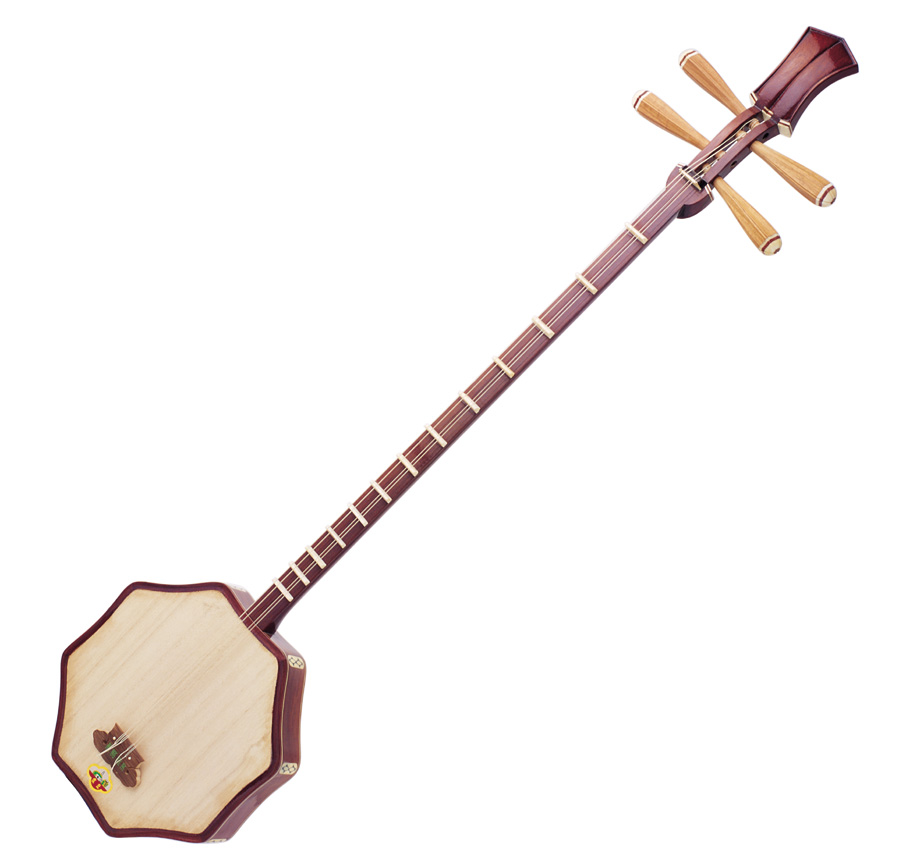
秦琴,是由古代的“阮咸”发展衍变而成。“阮咸”相传乃竹林七贤之一的阮咸所创制。据《国史篡异》和《事物原始》等书籍记载,有人破古墓发现一件带长柄而体圆的十三品柱乐器,疑为阮咸所作,遂以木仿制,并将之称为“阮咸”。千百年来,流传各地,因生㓉习惯和演奏传统,各地不一,式样尺寸,长短厚薄,都发生了很大变化。
秦琴,弹拨乐器,现代型制称六瓣的为“梅花秦琴”,以檀木为体,桐板作面,设覆手,配三弦,柄设十七品。
“梅花秦琴”原出潮州的二弦乐器“双清”,二十世纪二十年代后,被广府音乐家改制,配用三组较粗的弦,使成中音乐器。常用于广东音乐合奏中,遂成广东的特性乐器。
Qinqin is developed from the ancient instrument called ruanxcian. According to the historical materials, ruanxian was firstly introduced by RUAN Xian of the Seven Sages of the Bamboo Grove in the third century. After few centuries, it was rediscovered and widely spread in many districts with alternative developments.
Nowadays, qinqin is developed into a six-segment shade form called meifa qinqin. It is a plucking instrument with wooden sound box like yueqin, bearing a long stem with 17 frets and three strings.
Meifa qinqin is formerly derived from Chaozhou two-string instrument called shuangqing and be transformed to an alto instrument with three strings by Cantonese musicians in early twentieth century. It is later widely used in Cantonese music performing and become a model instrument.
箜篌 -Konghou
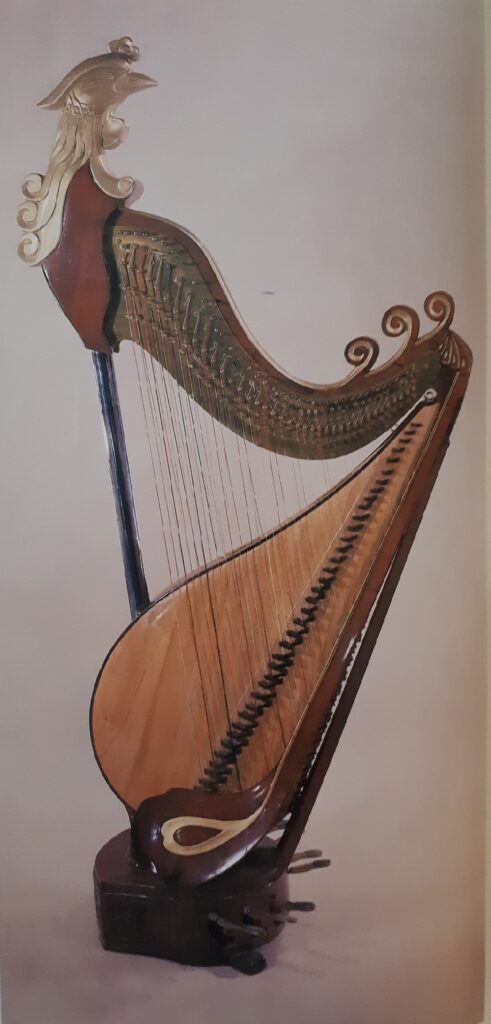
箜篌是拨奏弦鸣乐器,中国古代曾先后出现卧箜篌、竖箜篌、凤首箜篌三种形制。
以上三种形制的古代箜篌均已失传。二十世纪三十年代上海大同乐会曾有複制箜篌的尝试,制作了大、小箜篌和凤首箜篌,但未能推广。从二十世纪五十代末期起先后有数种试制箜篌的设计方案。其中雁柱箜篌是较成功的一种。它是从七十年代开始,由专业音乐学者和乐器制作工人结合,借鉴了竖琴的某些特点并参考我国民族乐器的制作原理重新研制而成的。雁柱箜篌以古代竖箜篌造型为基础,其共鸣箱不似原竖箜篌设在向上弯曲的曲木上,而是以侧面琵琶形状制成双面立式共鸣箱,在共鸣箱上利用古筝的压振原理做了双排导音码,并在共鸣箱后装置了双排弦揉音压颤的机件。琴体由琴座、琴柱、弦轴板、立式共鸣箱(桐木制)、双排导音码、压颤机件、凤头、音孔等部分组成。琴高一米七八,重四十公斤,七十二弦(三十六组同度弦),七声音阶排列,音域a1-b3(按颤音的音域为C-c3),用于独奏、伴奏和合奏。
–Konghou
Konghou is a kind of plucked instrument which had three designs the horizontal, the vertical and the Phoenix head in the ancient times. These three kinds of konghou had already failed to pass down to us. In 1930s, Shanghai Ta Tung National Music Research Institute has copied it from the old design, but cannot popularize. In 1970s, scholars and manufacturers based on the distinguishing features of the harp and the characteristics of the traditional instruments developed a new kind of konghou. This new instrument bears seventy two strings in heptachord. Its range is a1-b3 and is commonly used for solo, accompaniment and orchestral works.

